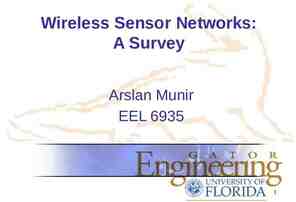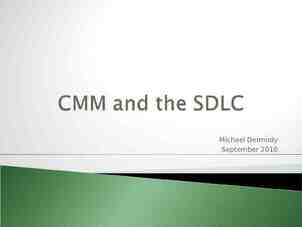CS 501: Software Engineering Fall 2000 Lecture 3 (a) Feasibility
27 Slides219.50 KB
CS 501: Software Engineering Fall 2000 Lecture 3 (a) Feasibility Study (b) Requirements Definition
Administration Assignment 1: Look on the course web site Project teams: If you have definitely chosen a project, please notify the Teaching Assistants with the names of your team members If you do not have a team you can meet after class Monday's recitations session will be to help the people who do not have projects form teams We may ask teams to add extra members A Teaching Assistant will be added to each team.
Feasibility Study Before beginning a project, a short, low-cost study to identify Client Scope Potential benefits Resources needed: staff, time, equipment, etc. Potential obstacles Where are the risks? How can they be minimized?
Feasibility Study A feasibility study leads to a decision: go ahead do not go ahead think again In production projects, the feasibility study often leads to a budget request. In research, a feasibility study is often in the form of a proposal.
CS 501: Client In CS 501, you have two clients: The client for the project The professor for the course Can you satisfy them both?
Scope What are the boundaries of the project? CS 501 Examples: Static web pages with open access on the Web [Web Profiler] Used by the general public [Digital Collections] Varying data formats [Legal Information] Thousands of sensors [Data mining] Support for Windows, Mac, Unix [SALSA]
Potential Benefits Why are you doing this project? Examples Create a marketable product Improve the efficiency of an organization Control a system that is too complex to control manually New or improved service Safety or security Get a good grade on CS 501
Resources Examples: CS 501 Staff: 5 to 7 students, with some help. How many hours per week? What skills do people have? Time: Must be completed by end of semester, including operational system, documentation, presentation Equipment and software: What special needs are there? Client: Will the client be sufficiently available and helpful?
Obstacles CS 501 projects Start-up time. Creating a team, scheduling meetings, acquiring software, learning new systems, . Business considerations. Licenses, trade-secrets, . Too ambitious. Nothing to show at the end of the semester. Changing circumstances. Client leaves the university, . What else?
How to Minimize Risk? CS 501 Projects Several target levels of functionality: required, desirable, optional Visible software process: intermediate deliverables Good communication within team and with Teaching Assistant Good processes lead to good software Good processes reduce risk
Feasibility Report A written document For a general audience: client, financial management, technical management, etc. Short enough that everybody reads it Long enough that no important topics are skipped In CS 501, I am looking for a well written, well presented document.
Requirements Definition and Analysis Requirements Definition System and Software design Programming and Unit Testing Integration and System Testing Operation and Maintenance
Example: Library of Congress (A Partial Failure) Outline Description The Library of Congress requires a repository system to store and make accessible very large amounts of highly varied material over long periods of time.
Chronology 1993-94 CNRI carries out research on architectures for digital libraries 1995-97 CNRI implements prototype repository for Library of Congress 1998 CNRI and Library of Congress carry out requirements definition
The Repository Repository Users Identification System Search System
Storage and Representation of Complex Objects Data Several representations: thumbnail image reference image archival image Metadata Each representation may have its own metadata
Repository: Research Achievements 1. CORBA implementation of repository access protocol. 2. Integration of persistent naming through handle system. 3. Use of structural metadata to describe complex objects, elementary typology. 4. Access management framework and implementation. 5. Applet-based middleware for user interfaces. 6. Information visualization program to view the structure of large collections.
Good Discoveries During Prototype Structuring complex information in digital libraries Data driven digital library interfaces Comparison of object-oriented, relational, and file based storage systems Naming and identification of library objects Boundaries of required repository system
Bad Discoveries During Prototype Resistance to change within Library of Congress Technical weakness of Library of Congress Gaps in CNRI architecture
Mistakes Confusion of objectives (research and implementation) Failure to involve all stakeholders Over-ambitious (no proper feasibility study)
The Requirements Process Feasibility Study Feasibility Report Requirements Analysis Requirements Definition System Models Requirements Specification Definition of Requirements Requirements Document Specification of Requirements
Requirements Definition High-level abstract description of requirements: Specifies external system behavior Comprehensible by customer, management and users Should reflect accurately what the customer wants: Services that the system will provide Constraints under which it will operate
Library of Congress Requirements Study Team (all experienced): Librarian, Software Engineer (CNRI), Computing Project Leader (Library of Congress), 2 others Advisors: Mailing list of about 20 knowledgeable stakeholders. Timetable: Preliminary report (2 months). Final report (1 month).
Functional Requirements Example: Library of Congress repository Support for complex digital objects Access management Identification Information hiding Open protocols and formats Integration with other systems (scope)
DRAFT OVERVIEW OF ITS SUPPORT FOR NDLP PRODUCTION AND DELIVERY OF AMERICAN MEMORY NDLP collections already released Coolidge collection (for repository test) NDLP collections in conversion Future NDLP collections Other applications and materials NDLP Workflow Tracking Support Current Storage Structure (in Unix files, by aggregate) Object Administration System ILS Repository Index Generation (including pre-processing) American Memory User Interface (retrieval, navigation, & display) AM user interface plus access management for objects/collections Other User Interfaces (e.g. RLG, OCLC, DLF partners) ILS OPAC Interface Supporting infrastructure Handle assignment & registration Handle-server NOW Handle resolution FUTURE
Non-functional Requirements Environment: Estimates of sizes, numbers of users, etc. Reliability and performance measures and targets Preferred: Example: Library of Congress repository Hardware and software systems (e.g., IBM/Unix) Database systems (e.g., Oracle) Programming languages (e.g., C and C )
Evolution of Requirements If the requirements definition is wrong, the system will be a failure. With complex systems, understanding of requirements always continues to improve. Therefore. The requirements definition must evolve. Its documentation must be kept current (but clearly identify versions).
































